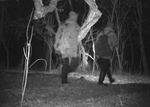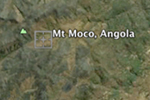
The face of the blue bottle fly (Calliphora vomitoria). New research shows how this carrion-eater carries the mammals of the forest in his stomach. Photo by: J.J. Harrison.
Last year scientists released a study that is likely to revolutionize how conservationists track elusive species. Researchers extracted the recently sucked blood of terrestrial leeches in Vietnam’s remote Annamite Mountains and looked at the DNA of what they’d been feeding on: remarkably researchers were able to identify a number of endangered and rarely-seen mammals. In fact two of the species gleaned from these blood-meals had been discovered by scientists as late as the 1990s. In the past, trying to find rare and shy jungle animals required many man hours and a lot of funding. While the increasing use of remote camera traps has allowed scientists to expand their search, DNA sampling from leeches could be the next big step in simplifying (and cheapening) the quest for tracking the world’s mammals. But now a new study in Molecular Ecology adds another twist: flies.
Led by Sebastien Calvignac-Spencer with the Robert Koch Institute, a team of scientists have analyzed the DNA found in the stomachs of blood-devouring flies, known as blow flies and flesh flies; these are insects that feed on carrion, open wounds, or even feces, taking the animals’ DNA with them. Unlike the leech study, which only focused on Vietnam, Calvignac-Spencer and his team took samples from flies in two parks, one in Madagascar (Kirindy Reserve) and another in Cote d’Ivoire (Tao National Park).
“The main advantage in using flies is their worldwide distribution. Terrestrial leeches are on the contrary restricted to the tropical belt and even there cannot be found everywhere (for example they do not occur in the two forests in which we led our study),” Calvignac-Spencer told mongabay.com. In fact since terrestrial leeches are found neither in Kirindy Reserve or Tao National Park, flies were the next logical choice.
 Pygmy hippos in a Kenyan Reserve. |
When the researchers put their flies to the test they were surprised by the abundant results. In Tao National Park, the researchers uncovered 16 mammals from the flies, including the pygmy hippopotamus (Choeropsis liberiensis) and Jentink’s duiker (Cephalophus jentinki), both of which are listed as Endangered by the IUCN Red List.
“One surprise was that we could sample the entire local community of primates [in Tao National Park] by analyzing ca. 120 flies,” Calvignac-Spencer told mongabay.com, which he called “not a tremendous effort” for getting DNA on all nine primate species in the protected area.
In Madagascar’s Kirindy Reserve, the researchers were able to identify DNA from four mammal species, including the gray mouse lemur (Microcebus murinus) and the fat-tailed dwarf lemur (Cheirogaleus medius). While four mammals may not sound like much, the researchers were able to get this data from just 40 or so flies.
While the study’s authors write that carrion flies “represent an extraordinary and thus far unexploited resource of mammal DNA,” Calvignac-Spencer says that this doesn’t mean leeches should be avoided where available.
“Mammal DNA will probably be of better quality and persist longer in leeches than in flies,” he notes. Indeed last year’s study, found that DNA in leech blood-meals was still viable after four months or about the time it takes a terrestrial leech to get hungry again.
“As exemplified here, both [subjects] have pros and cons,” Calvignac-Spencer says. “So we expand the toolbox for conservation biologists but in no case say that it will supersede in all instances those already available.”
One other expansion that may be underway is using the new technology to track not just mammals, but birds, reptiles and amphibians too. In fact, Calvignac-Spencer’s research identified the DNA of the water rail (Rallus aquaticus) in a number of flies from Kirindy Reserve. In Tao National Park, they were able to extract the DNA of a hornbill and a frog, though were not able to track it all the way down to the species level.
 Terrestrial leech in Borneo. Photo by: Rhett A. Butler. |
Calvignac-Spencer cautions that finding DNA from non-mammal “is not a formal proof that it would work as well […] but this is a possibility to explore.”
Still, even as promising as the new method is, there are still some hiccups. For example, a number of the mammals could not be identified to their species level. Rats, mice, and shrews proved particularly difficult.
“The reason is that the database to which we compared our sequences did not contain sequences for all possible species,” explains Calvignac-Spencer. “This shows that the precision of our assignment (family/genus/species level) critically depend on the quality of reference databases, although an exhaustive database is not a strict prerequisite.”
Still, the new method has a ton of advantages: it’s non-invasive, it requires little more to do in the field than catching flies, and may be able to be done on the cheap, according to Calvignac-Specncer, especially if “next generation sequencing strategies are implemented.”
“We expect that costs in personnel will sharply decrease when compared to classical methods, e.g. transects, etc,” he notes. “Indeed there is no need to train people to recognize species (which takes a lot of time) and setting up fly traps is extremely fast and easy.”
Someday, leeches and flies may be used not only to identify which species are lurking in the woods, but also to estimate abundances, track population crises, prove or disprove the existence of a cryptic species, and even to find out the best places to look for new species.
CITATION: Sébastien Calvignac-Spencer, Kevin Merkel,
Nadine Kutzner,
Hjalmar Kühl,
Christophe Boesch,
Peter M. Kappeler,
Sonja Metzger,
Grit Schubert,
Fabian H. Leendertz. Carrion fly-derived DNA as a tool for comprehensive
and cost-effective assessment of mammalian biodiversity. Molecular Ecology. 2013. DOI: 10.1111/mec.12183
Related articles
Does the Tasmanian tiger exist? Is the saola extinct? Ask the leeches
(04/30/2012) The use of remote camera traps, which photograph animals as they pass, has revolutionized research on endangered and cryptic species. The tool has even allowed scientists to document animals new to science or feared extinct. But as important as camera traps have become, they are still prohibitively expensive for many conservationists and require many grueling hours in remote forests. A new paper in Current Biology, however, announces an incredibly innovative and cheaper way of recording rare mammals: seek out the leeches that feed on them. The research found that the presence of mammals, at least, can be determined by testing the victim’s blood for DNA stored in the leech.
How a text message could save an elephant or a rhino from a poacher
(01/15/2013) Soon a text message may save an elephant’s or rhino’s life. The Kenya Wildlife Service (KWS) is implementing a new alarm system in some protected areas that will alert rangers of intruders via a text message, reports the Guardian. Elephants and rhinos have been killed in record numbers across Africa as demand for illegal rhino horns and ivory in Asia has skyrocketed.
Advanced technology reveals massive tree die-off in remote, unexplored parts of the Amazon

(12/12/2012) Severe drought conditions in 2010 appear to have substantially increased tree mortality in the Western Amazon, a region thought largely immune from the worst effects of changes occurring in other parts of the world’s largest rainforest, reported research presented last week at the fall meeting of the American Geophysical Union (AGU). The findings suggest that the Amazon may face higher-the-expected vulnerability to climate change, potentially undercutting its ability to help mitigate greenhouse gas emissions by absorbing carbon dioxide through faster growth.
Conservationists turn camera traps on tiger poachers

(11/12/2012) Remote camera traps, which take photos or video when a sensor is triggered, have been increasingly used to document rare and shy wildlife, but now conservationists are taking the technology one step further: detecting poachers. Already, camera traps set up for wildlife have captured images of park trespassers and poachers worldwide, but for the first time conservationists are setting camera traps with the specific goal of tracking illegal activity.
3-D laser mapping shows elephants have big impact on trees
(08/06/2012) Scientists have long known that African elephants (Loxodonta africana) are talented tree-topplers, able to take down even large trees in order to gobble out-of-reach leaves. However the extent of his behavior across a large area has been difficult to quantify. But a new study in Ecology Letters has used a bird’s-eye view—with 3-D—of Kruger National Park in South Africa to determine the impact of elephants on trees.
10 African countries to develop satellite-based deforestation tracking systems with help of Brazil
(07/30/2012) Ten tropical African countries will receive training and support to develop national forest monitoring systems, reports the United Nations. Brazil, which has an advanced deforestation tracking system, will guide the initiative in partnership with the Central Africa Forests Commission (COMIFAC) and the UN Food and Agriculture Organization (FAO).
Smartphones promoted as a tool for indigenous forest protection
(07/23/2012) Smartphones beeping in the woods may be a welcome presence that augurs the increased ability of indigenous communities to be stewards of their own biodiverse forests. Representatives of these communities and their supporters have advocated that international conservation policies like Reduced Emissions through Deforestation and Degradation (REDD) be increasingly managed by the communities themselves.
Google Earth used to discover unknown forest in Angola, scientists find it full of rare birds

(07/09/2012) An expedition, followed up by some computer hunting on Google Earth, has discovered large remnants of old growth forest, including thriving bird communities, in the mountains of Angola. The Namba Mountains in Angola were expected to contain around 100 hectares of forest, but an on-the-ground survey, coupled with online research, has discovered numerous forest fragments totaling around 590 hectares in the remote mountains, boosting the chances for many rare species.